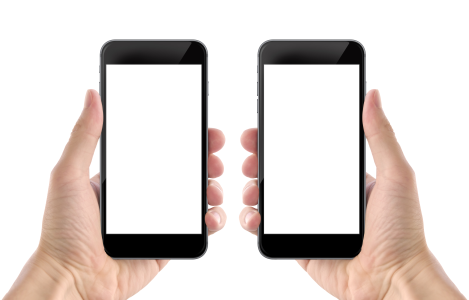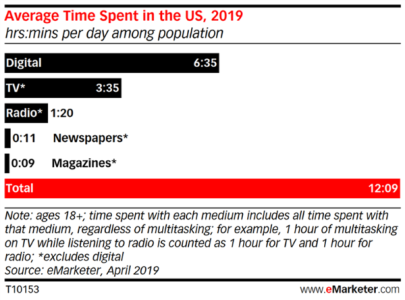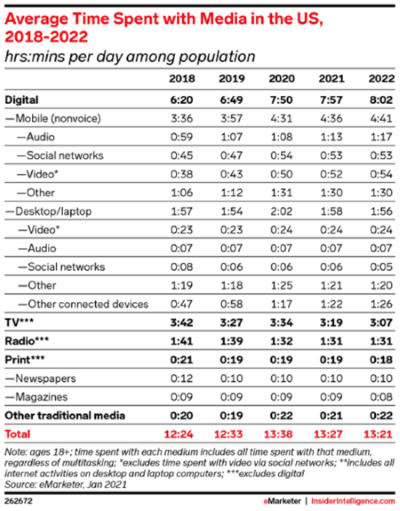Americans consume 15.5 hours of media a day — outside work
When was the last time you found yourself text messaging while checking email, watching TV and talking on the phone?

You’re not alone: Americans consume, on average, 63 gigabytes of media a day, according to a 2013 report by the University of Southern California’s Institute for Communications Technology Management. That’s the equivalent of:
- 63 hours of streaming video[1]
- 63,000 hours of streaming music
- 10,000 times the Complete Works of Shakespeare[2]
That’s 15.5 hours of media a day — not including time at work.
Let’s do the math: Let’s assume that eight hours at the office, eight hours of sleep, plus nearly 16 hours of watching, listening and reading. That’s 32 hours a day.
They can’t be paying attention to it all!
Linda Stone coined the term “continuous partial attention” in 1998 to describe this problem. CPA is an automatic process where, motivated by a desire to be productive and efficient, we are constantly looking at media, but never paying full attention to any message.
The result? We feel a sense of constant crisis trying to keep up with opportunities, activities and contacts on emerging technology. All of this FOMO means we can’t really pay attention to anything.
‘More than 24 hours in a media day’
Consider the numbers:
- Three in 10 U.S. adults are “constantly” online, according to the Pew Research Center.[3] And 20% of Americans “constantly” monitor their social media feeds.
- American adults spend more than 12 hours a day listening to, watching, reading or interacting with media, according to the first-quarter 2020 Nielsen Total Audience Report.[4] That’s nearly half of a person’s day. 50- to 64-year-olds are connected an average of 13 hours and 20 minutes a day.[5]
- Make that 12 hours and 9 minutes a day[6], according to eMarketer. (Why the different numbers? Different researchers simply count differently.)
- Make that 15.5 hours a day, according to USC.
No wonder you sometimes feel like a live node on the network.
“One can actually have more than 24 hours in a media day,” says James E. Short, author of the USC report. “And as we increase our level of multi-tasking, we have to expect that total hours will grow even as the total number of physical hours a viewer can consume media will remain roughly constant.”


If your readers reading your message while watching “The Crown,” trying to memorize the lyrics to “Guns & Ships” and texting their sister about Christmas plans, how much is getting through?
“Multitasking, when it comes to paying attention, is a myth,” says John Medina, who’s studied how the mind reacts to and organizes information. In Brain Rules, he points out that humans are “biologically incapable of processing attention-rich inputs simultaneously.”
Indeed, even students at MIT and Stanford, researchers found in a 2009 study, couldn’t focus when drowning in data.
‘You’re not more informed’
“We take it, as a given, that the more information decision makers have, the better off they are,” writes Malcolm Gladwell writes in Blink. “But … all that extra information isn’t actually an advantage at all.
“In fact, that extra information is more than useless. It’s harmful. It confuses the issues.”
As Tom Rosenstiel, former media critic for the Los Angeles Times, says:
“You’re not more informed. You’re just numbed.”
Inform, don’t just numb, your audience.
Learn strategies for attracting and retaining audiences members with an artificial sense of constant FOMO. Learn tactics for getting the attention of readers driven by a conscious desire to keep up with everything, all of the time.
_____
Appendix
[1] Andrew Moore-Crispin, “How many megabytes are in a gig? Understanding mobile data,” Ting, June 21, 2017
[2] “How much is 63 gigabytes?” The Measure of Things
[3] Andrew Perrin And Sara Atske, “About three-in-ten U.S. adults say they are ‘almost constantly’ online,” Pew Research Center, March 26, 2021
[4] The Nielsen Total Audience Report: August 2020 — Special Edition: Work-From-Home, Aug. 13, 2020
[5] Audrey Schomer, “US Time Spent with Media 2021,” eMarketer, May 27, 2021

Leave a Reply